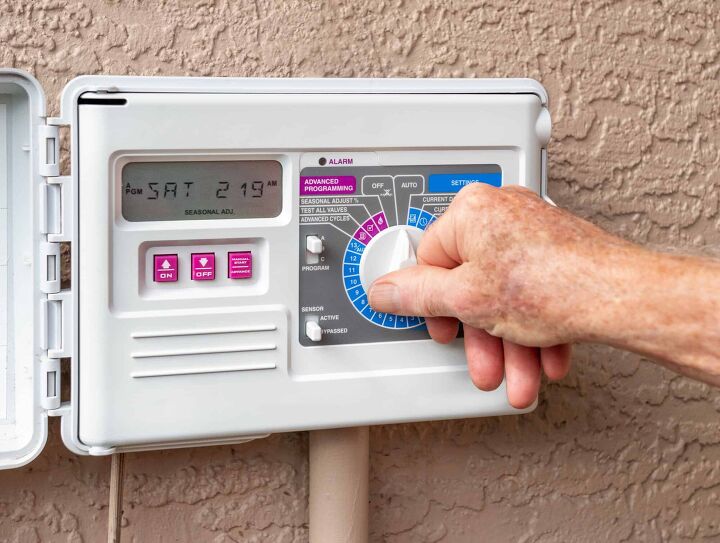Parts of a Sprinkler System (List of Components With Photos)

The conventional sprinkler system found on residential properties does the majority of the work under the ground, and out of view. Despite their enigmatic nature, irrigation systems aren’t particularly complicated. In fact, they consist of only a few main basic components, each of which has the primary goal of distributing water to the correct place at the proper time.
To both understand how a sprinkler system works and be able to diagnose issues when they arise, it’s important to know all the parts of a sprinkler system. Although they are made up of a number of different pieces, your average yard irrigation system can be broken down into ten basic parts: water source, the timer (or, controller), backflow preventer, water pump, water meter, control valves, valve box, shut-off valve, sprinkler heads, and the pipes and risers.
Do You Need to Hire a Sprinkler System Contractor?
Get free, zero-commitment quotes from pro contractors near you.

Primary Parts of a Sprinkler System
1. The Water Source
Although not necessarily a part of your sprinkler system, the entire anatomy begins at the water source. Without water, your sprinkler system simply cannot operate. The source of water can come from the local water supply, a well, pump, or even a nearby stream or pond.
Depending on the source, water is supplied to your mainline and then branches off to either your home or irrigation system.
2. The Timer
In most modern sprinkler systems, an electronic timer (or controller) is the brain. It controls the flow of water from the main water source to the rest of the system. The timer is what communicates to the valves when to open or close. By controlling the valves, the timer allows you to control which areas of the system function at a given time.
A traditional controller will allow you to set a regular watering schedule. Some, more advanced, timers allow you to set different parts of the system on their own individual schedule. Other advanced timers may feature moisture sensors that automatically determine when the system needs to be shut off. For example, these types of timers will know to suspend the watering schedule if it’s raining.
3. The Backflow Preventer
When your sprinkler system is connected to a potable water supply, the backflow prevention device (BPD) is what protects the water source from possible contamination. It prevents contaminated water from flowing backward into your drinking water – hence the name “backflow preventer.”
Backpressure is what occurs when the pressure in your system is greater than the supply pressure. As a result, contaminated water is pushed back into the potable water supply. However, these issues are avoided when you have a backflow preventer.
Back-siphonage is another way that your water supply can become contaminated. It occurs when negative or loss of pressure sucks water from your sprinkler system into the water source, allow hazardous chemicals to enter your drinker water. Like backpressure, back-siphonage can also be prevented by installing a backflow preventer.
Depending on where you live, you may be required by law to have a backflow preventer installed on your irrigation system.
4. The Water Pump
While the timer is the brain, the water pump is the heart of a sprinkler system. For smaller installations, you might have a single booster pump. Whereas, most sprinkler systems will need multiple irrigation pumps installed.
The purpose of a water pump is to deliver the appropriate level of water pressure for the system to function properly. While the water pressure of your municipal water supply may be sufficient to operate a garden hose hooked up to a portable sprinkler, an irrigation system needs much higher water pressure.
High pressure, provided by the water pump, allows water to be efficiently pumped through the pipes and to the sprinkler heads.
5. The Water Meter
As you might assume, the water meter measures the amount of water that is used to irrigate your lawn. It allows you to ensure that the appropriate amount of water is being serviced to the various zones.
However, in some cases, the water meter may be a component of your water utility setup. Depending on your municipality, you may be charged a fee for water usage and water sewage treatment. Under normal circumstances, the amount of water used is how the sewage treatment fees are determined.
6. Control Valves
In a conventional sprinkler system, a series of valves are what control the flow of water through the system. Since water pressure is generally insufficient to operate the whole system at once, the valves are what divide the system into designated zones. These sprinkler zones all function independently of one another.
If your system has an electronic timer, the valves are controlled by the timer which opens and closes them according to the encoded watering schedule. The control valves are hooked up to the timer with wires, which transmit the control signals.
In many cases, control valves are grouped together in a “manifold,” or an arrangement that helps make maintenance easier and minimize wiring needs.
7. The Valve Box
Valve boxes are, as the name indicates, a box for housing the valves. However, that isn’t all they’re used for. They are placed underground and used to encase a number of components of your sprinkler system. The valve box allows convenient access for the homeowner to easily get to the sprinkler valve, along with other components such as the wires, sensors etc.
Not to mention, the housing protects all the parts inside of the valve box from pests, outdoor elements, and accidents (like errant lawnmowers). By using valve boxes, properly installed sprinkler systems can be nearly invisible but still easily accessible for repairs and maintenance.
8. The Sprinkler Shut-Off Valve
While the idea of a shut-off valve may seem simple, when it’s included in a well-designed irrigation system, the sprinkler shut-off valve plays a crucial role in preventing and alleviating potentially destructive problems.
Along with the solenoid switch, power supply, and a well-programmed controller, the system will shut off the water supply the moment issues are detected. By meticulously planning out your sprinkler system’s zones and installing sufficient shut-off valves, you can reduce disruptions and maximize the protection of your entire system.
9. The Sprinkler Heads
Sprinkler heads are placed around your property to help provide full water coverage to your lawn and garden. There are a number of different types of sprinkler heads, with the most common being those that retract to rest at or slightly below ground when not in use. They come in a range of types that are designed for different applications. Here are some popular examples:
- The pop-up style sprinkler head hides underneath the ground, or right at grade level, and pops up when the particular zone is activated. These types of sprinkler heads are generally used for lawns, ground covers, and low-growing flower beds.
- The shrub style sprinkler head are elevated and fixed on shrub sticks (or risers). These types of sprinkler heads extend out of the ground to the level of the greenery that requires irrigation. Additionally, this allows your sprinkler system to service higher plants and shrubs.
Both the pop-up style and shrub style can be found in rotor heads and spray heads.
- Rotor sprinkler heads operate with a rotating stream, or multiple streams, that water your property. They are often used to water areas that are over eighteen feet wide and for medium to large lawns. Rotor heads rotate left and right to efficiently apply water to the intended area.
- Spray sprinkler heads drive a fixed water pattern, as opposed to a stream of water, in the form of a mist spray or water droplets. These types of sprinkler heads are usually used for smaller lawns and flower beds.
Some other types of sprinkler heads include oscillating and stationary. Oscillating heads rotate to cover a large area, while the stationary variety directs the water to a specific area and sprays a pattern that can range from a narrow arc to a full circle. Drip heads, or low-flow, are intended to deliver a small amount of water directly to planting beds, which significantly reduces water waste.
10. Pipes and Risers
To carry water from the main water source to the control valves and then from the valves to the sprinkler heads, a system of horizontal PVC piping is used. Whereas, risers refer to the vertical pipes that extended upward from the horizontal pipes in the areas where sprinkler heads exist. The risers are directly attached to the sprinkler heads.
Additional Sprinkler Parts to Consider
While the above are the most basic components, with every irrigation system there are a number of additional parts that can be installed to make your system run smoother and your life much easier. Here are some extra parts that don’t come standard, but you may consider adding to your sprinkler system for added convenience:
- Weather Sensors: Weather sensors are especially beneficial for those who live in a climate with ever-changing weather elements. They will turn off your sprinkler system in conditions such as high wind, freezing temps, rain, and possible over-flow situations.
- Remotes: Using a remote for your sprinkler system can make it easy and convenient to operate it from inside your home. They are ideal for busy individuals.
- Sprinkler Head Filters: Installing filters on your sprinkler heads helps to keep them clear of dirt, rocks, and debris, which prevents clogs in the system.
- Sprinkler Tools: The type of tools you already have at home will determine the additional tools you may need to install, maintain, or repair your system. These tools may include sprinkler head adjustment tools, picks, rakes, PVC utters, primer, glue, and a shovel.
- Batteries: Even if your timer operates with electricity, having a backup battery can be helpful in case of an emergency. Check to see what type of battery your controller takes before you head out and make your purchase.
- Underground Fertilizer: There are particular types of fertilizer that are designed to be hooked up to your sprinkler system. To give your lawn an extra boost, the fertilizer will spray out of the sprinkler heads when they’re on.
- Replacement Parts: There is nothing more inconvenient than not being able to water your lawn because you’re waiting for a replacement part. Consider purchasing some replacement parts when you make the initial purchase of your sprinkler system. That way, you will be fully prepared when an emergency might arise.
Do You Need to Hire a Sprinkler System Contractor?
Get free, zero-commitment quotes from pro contractors near you.

Final Thoughts
Having a sprinkler system allows you to have more control over when and how your lawn is watered. Despite your sprinkler system’s manufacturer or specific model, all lawn irrigation systems tend to have the same main basic parts. Piping is buried under the ground, which are attached to the various sprinkler heads strategically positioned in designated zones.
The heads operate based on water pressure, and how and when the water is distributed is controlled by an electric timer or controller. The controller tells the control valves to open and close based on the watering schedule. Having a basic understanding of the parts of a sprinkler system and how they work can make operating them much easier!
Related Guides

Jessica considers herself a home improvement and design enthusiast. She grew up surrounded by constant home improvement projects and owes most of what she knows to helping her dad renovate her childhood home. Being a Los Angeles resident, Jessica spends a lot of her time looking for her next DIY project and sharing her love for home design.
More by Jessica Stone
















![How Much Weight Can a 4×4 Support Horizontally? [It Depends!]](https://cdn-fastly.upgradedhome.com/media/2023/07/31/9070333/how-much-weight-can-a-44-support-horizontally-it-depends.jpg?size=350x220)










![12 Washing Machine Brands to Avoid [with Recall Data]](https://cdn-fastly.upgradedhome.com/media/2023/07/31/9075781/12-washing-machine-brands-to-avoid-with-recall-data.jpg?size=350x220)





